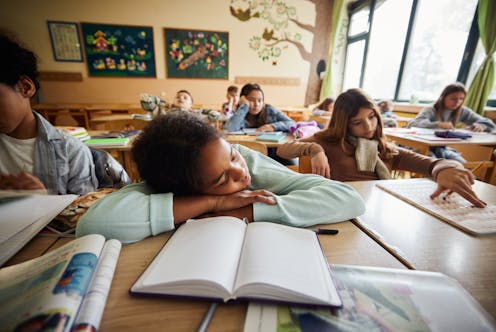Seven 'great' teaching methods not backed up by evidence
 We know what doesn't work. Teaching via Shutterstock/michaeljung
We know what doesn't work. Teaching via Shutterstock/michaeljungWhat makes “great teaching”? It’s a complicated question, made more difficult by trying to measure how teachers make decisions in the classroom and what impact those decisions have on what pupils learn.
In a new report for the Sutton Trust, we have tried to set out how great teaching leads to great learning. Our overall aim is to see whether setting out a framework of indicators that focus teachers’ effort on things which are important can help their pupils learn even better.
Some things we are pretty sure about. Effective teachers have good knowledge about what they teach and know how best to communicate this to their students. They have a high level of skill in questioning pupils and assessing what they know and can do. They have high expectations and set a climate which promotes challenge and values success. Most of our report looks at effective classroom practices and how we can measure these.
What doesn’t work
We also think it is useful to look at what hasn’t been shown to work, even if this may seem a rather negative way to focus on improvement. Many ineffective teaching practices seem to be quite popular, even though most evidence is anecdotal and selective.
By stopping doing things that are either ineffective or inefficient, it should allow more time to focus on things that will make more of a difference. Here are seven common teaching practices that are not backed up by evidence.
No evidence for (1): Using praise lavishly
Praise for students may be seen as affirming and positive, but a number of studies suggest that the wrong kinds of praise can be very harmful to learning. Other research argues that praise which is meant to be encouraging and protective of low-attaining students can actually convey a message of the teacher’s low expectations. What is important is praise which is valued by the learner.
No evidence for (2): Allowing learners to discover key ideas for themselves
Enthusiasm for “discovery learning” where learners undertake problem-solving activities or open-ended tasks is not supported by research evidence, which broadly favours direct instruction where children are more explicitly guided through the learning process. Although learners do need to build new understanding of what they already know, if teachers want them to learn new ideas, knowledge or skills, they should teach them directly.
No evidence for (3): Grouping learners by ability
Evidence about the effects of grouping by ability suggests that it makes very little difference to learning outcomes. In theory, ability grouping might allow teachers to create lessons that have a narrower range of pace and content. But it can also create an exaggerated sense in teachers' minds that children in one group are very similar to each other, and that they are different to other groups. This can result in teachers not making the necessary accommodations for the range of different needs within a supposedly similar “ability” group and going too fast with the higher groups and too slow with the lower ones.
No evidence for (4): Re-reading and highlighting
 Doesn’t matter what colour, it probably won’t help.Dey, CC BY-NC-SA
Doesn’t matter what colour, it probably won’t help.Dey, CC BY-NC-SA
Re-reading and highlighting are among the commonest and apparently most obvious ways to memorise or revise material. They also give a satisfying – but deceptive – feeling of fluency and familiarity with the material. Yet a range of studies have shown that testing yourself, trying to generate answers and deliberately creating intervals between study to allow forgetting, are all more effective approaches.
No evidence for (5): Addressing issues of confidence and low aspirations
The evidence shows that attempts to enhance pupils motivation are unlikely be successful and even if they do, the impact on subsequent learning is close to zero. In fact the poor motivation of low attainers is a logical response to repeated failure. Start getting them to succeed and their motivation and confidence should increase.
No evidence for (6): Teaching to a learner’s preferred learning style
The belief in the importance of learning styles seems persistent. A recent survey found that more than 90% of teachers in several countries (including the UK) agreed with the claim that: “Individuals learn better when they receive information in their preferred learning style (for example, visual, auditory or kinaesthetic)”.
But the psychological evidence is clear that there are no benefits from trying to present information to learners in their preferred learning style.
No evidence that (7): Active learners remember more than passive learners
This claim is commonly presented in the form of a “learning pyramid” which shows precise percentages of material that will be retained when pupils have different levels of activity. These percentages have no empirical basis and are pure fiction. Memory is the residue of thought, so if you want students to remember something you have to get them to think about it. This can be achieved by being either “active” or “passive”.
By including some examples of “ineffective practice” in our research on what makes great teaching, we are likely to provoke a strong reaction from teachers and parents. We hope this can be challenging in a constructive way. Clearly, telling a professional teacher that some aspect of their practice is problematic is a risky way to get a productive discussion going. But thinking about what is effective as well as what isn’t can help clarify how to improve professional teaching practice.
Steve Higgins works for Durham University which received funding from the Sutton Trust to undertake this review.
Robert Coe has received funding from the ESRC, Sutton Trust, Education Endowment Foundation, Pearson, and many individual schools and local authorities.
Read more http://theconversation.com/seven-great-teaching-methods-not-backed-up-by-evidence-33647













